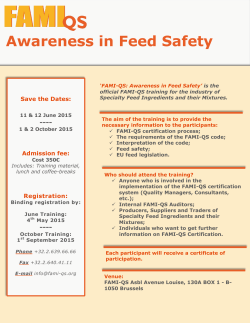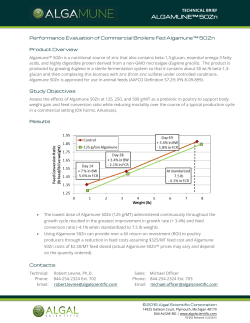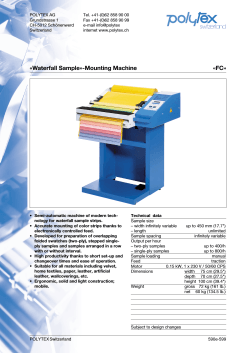
SOP-Feeding
(WRITE NAME OF THE FARM) SOP-Feeding SOP-Feeding describes the procedures that ensure uniform feeding of your cows. The description includes: • Loading • Mixing and feeding of TMR/PMR • Mixing and feeding of compact TMR/PMR • Silage management • Cleanup • Check the feed stock • Feed hygiene • Monitoring the load cells of the feed wagon Organic SOP-feeding describes the organic requirements for feeding (marked with a • Organic requirements for feeding • Feed statement • Preservation/silage ) and includes: All topics are illustrated with drawings and short texts that you can edit so it fits the conditions on your farm. When you organize and implement SOP on your farm, it is an advantage to involve a Lean-certified cattle adviser. You'll find them on www.leankvaeg.dk. Experience shows that an introductory course with the help of an expert is crucial for the output of SOP in the long run. In the guide "Getting Started with SOP" (attached), there are some guidelines you can consider before you begin to adapt SOP for your work procedures. Enjoy your SOP. SOP –working procedures for the best result Januar 2015 (WRITE NAME OF THE FARM) Content 1. Feeding – Loading of feed mixer ....................................................................... 2 2a. Mixing and feeding of compact feed ................................................................ 4 2b. Mixing and feeding of TMR .............................................................................. 9 3. Feeding - Feeding alley for cows and heifers .................................................. 10 4. Feeding - Silage management ......................................................................... 11 5. Feeding - Loading silage and tidying up .......................................................... 12 6a. Feeding - Correct removal with multi-purpose bucket .................................... 13 6b. Feeding - Correct removal with silage chopper .............................................. 14 6c. Feeding - Correct removal with silage (block) cutter ...................................... 15 7. Feeding - Feed in stock ................................................................................... 16 8. Feeding - Feeding hygiene .............................................................................. 17 Organic requirements - overview ................................................................... 18 9. Feeding – Organic requirements ............................................................... 18 10. Conservation and silage – organic requirements SOP Feeding - Januar 2015 1 / 22 ..................................... 21 (WRITE NAME OF THE FARM) 1. Feeding – Loading of feed mixer 1.1 Make sure the mixer is empty before starting a new mix 1.2 Enter number of cows into feed computer (It is assumed that the recipe has been typed in advance) 1.3 Add ingredients in the order specified on the ___ Feed computer ___ Printed recipe 1.4 Supplementary feed and mineral loading Vertical mixer Load supplementary feed and minerals into the middle of the mixer. SOP Feeding - Januar 2015 2 / 22 (WRITE NAME OF THE FARM) Paddle mixer Load supplementary feed and minerals into mixer wagon in full length of it. 1.5 Overview of feeding tasks Time 05.00 Task Push the feed in Responsible Peter (2177 7777) 06.00 Soak of supplementary feed in water Peter (2177 7777) 07.30 Half mix Peter (2177 7777) 08.00 End mix + clean the feed table at the cows Peter (2177 7777) 08.30 Feeding Peter (2177 7777) 15.00 Soak of supplementary beet pulp pellets Peter (2177 7777) SOP Feeding - Januar 2015 3 / 22 (WRITE NAME OF THE FARM) 2a. Mixing and feeding of compact feed 2.1a Soak supplementary feed at _____ (8,16) Filling in supplementary feed (see the display) Remember to start the mixer before adding water Gear on the feed wagon ______ (high/low, up/down) Start PTO when adding _______ (water) Tractor PTO ________ (1000) RPM ________ (1200) Mix time ______ (10) Minutes/rotations Mixture proportion (weight of dry compound feed + 50 % of dry weight as water) Supplementary feed in pellets can be treated in about an hour. Beet pulp pellets need longer time (8-10 hours). Is done by______________ (intermediate bulk container, load shovel, hoseaddition) Add additives_________ (acid) Check that no dry feed is on top of the auger SOP Feeding - Januar 2015 4 / 22 (WRITE NAME OF THE FARM) 2.2a Sugar beet concentrate premix _______ (morning/evening) Filling in supplementary feed and clean sugar beets Gear on the feed wagon ______ (high/low, up/down) Start PTO when adding _______ (silage) Tractor PTO ________ (1000) RPM ________ (1200) Mix time ______ (10) Minutes/rotations Is done by______________ (intermediate bulk container, load shovel, hoseaddition) Add additives_________ (acid) Check that no dry feed is on top of the auger Vil du vide mere – køb hele SOP’en HER SOP Feeding - Januar 2015 5 / 22 (WRITE NAME OF THE FARM) 2.3a HALF MIX Is done at _______ (10) Restrictor blades_______ (out) Gear on the feed wagon ______ (high/low, up/down) Tractor PTO ________ (1000) RPM ________ (1200) Start PTO Filling in____________ (grass silage and other straw feed) Mix just before feeding, don’t stop mixer before unloading Mix time ______ (10) Minutes/rotations DO NOT STOP THE MIXER BEFORE UNLOADING 2.4a END MIX Mixing tub must be in straight level Filling in maize silage Vil du (10) vide Mix time ______ Minutes/rotations mere – køb hele SOP’en HER Remember to control that the whole mix is moving in vertical auger mixer Remember to control that paddle mixers are not overloaded DO NOT STOP THE MIXER BEFORE UNLOADING SOP Feeding - Januar 2015 6 / 22 (WRITE NAME OF THE FARM) 2.5a Feeding start Tractor PTO _____ (1000) RPM _____ (1200) Gear _____ (2L) Notice________(terrain, curves) 2.6a 2.7a Indicators in cattle house ________ (Ex. hatch) ____ (2000) kg left Tractor PTO _____ (1000) RPM _____ (1200) Gear _____ (2L) When mixer is almost empty Tractor PTO _____ (1000) RPM _____ (1200) Gear _____ (2L) 2.8a Control the eating-behaviour of the cows Vil du vide mere – køb hele SOP’en HER Cows eat__________ (from top or from below)? Estimate the homogeneity of the ration (grass chunks, particle size, adhesiveness, small particles separation, and pellets) Report to_______(cowman, advisor) SOP Feeding - Januar 2015 7 / 22 (WRITE NAME OF THE FARM) 2.9a Push up feed - at__________(15.00) and - at__________(23.00) 2.10a Refusals must be appropriate ___(<1) kg per cow = feed more ___(1) kg per cow = appropriate ___(>1) kg per cow = feed less Measure/weigh by_______(loadings of_____ , in mini loader) Report unusual findings to____________(cowman) 2.11a Score refusals - amount - availability - composition (are refusals similar to feed mix) Vil du invide mere - spoiling/heat refusals – køb hele SOP’en HER Report to_________(cowman, advisor) SOP Feeding - Januar 2015 8 / 22 (WRITE NAME OF THE FARM) 2b. Mixing and feeding of TMR 2.1b Start PTO when adding _______ (silage) Start PTO when adding __________ Tractor PTO _____ (1000) RPM _____ (1200) Gear _____ (2L) 2.2b Max ____ (10) min. mixing time after _____ (silage) is added 2.3b Feeding start Tractor PTO _____ (1000) RPM _____ (1200) Gear _____ (2L) 2.4b Indicators in cattle house ________ (Ex. hatch) ____ (2000) kg left Vil du vide Tractor PTO _____ (1000) RPM _____ (1200) Gear _____ (2L) 2.5b mere – køb hele SOP’en HER When mixer wagon is almost empty Tractor PTO _____ (1000) RPM _____ (1200) Gear _____ (2L) SOP Feeding - Januar 2015 9 / 22 (WRITE NAME OF THE FARM) 3. Feeding - Feeding alley for cows and heifers 3.1 Push up feed at _____ (15.00) and at _____ (23.00) Feeding starts at ________ (7.00 ) 3.2 Ensure an appropriate amount of feed Check ____ (2) hours before next feeding ____ (100) kg = feed more ____ (>500) kg = feed less In case of large deviations, contact _________________ 3.3 Are cows sorting the feed? Check the refusals before next feeding In case of large deviations, Vil du vide mere contact _________________ 3.4 – køb hele SOP’en HER Clean feed bunk/ alley before ________________ (morning feeding) Move refusals to ________ (heifers) Clean heifers’ feeding alley min. ___ (2) times a week SOP Feeding - Januar 2015 10 / 22 (WRITE NAME OF THE FARM) 4. Feeding - Silage management 4.1 Uncover the stack ____ (20) cm every ________ (second) day Use a hook to pull the cover away. Stay clear of the edge. 4.2 Avoid air under the plastic: Place heavy bags (sandbags or gravel bags) along the edge of the plastic 4.3 Cut off plastic and move it to ________________ (container) 4.4 Sort out poor and mouldy feed, and move it to _________________ (location) Vil du vide mere – køb hele SOP’en HER SOP Feeding - Januar 2015 11 / 22 (WRITE NAME OF THE FARM) 5. Feeding - Loading silage and tidying up 5.1 Remove silage with a clean cut Collect lost silage from the storage area and immediately feed it to ______________ (heifers) 5.2 Be careful to empty the contents of the bucket into the feed mixer wagon and not onto the ground 5.3 CORRECT! 5.4 NO! + Vil du vide mere – køb hele SOP’en HER SOP Feeding - Januar 2015 12 / 22 (WRITE NAME OF THE FARM) 6a. Feeding - Correct removal with multi-purpose bucket 6.1a Make sure the bucket is clean The grab must not be missing any tines, and bended tines must be replaced or straightened out 6.2a Make a clean-cut and vertical silage face 6.3a Attention! Avoid uneven silage face Avoid lifting up the silage and make sure to maintain a clean-cut silage face at removal 6.4a Attention! Avoid “biting off” silage with both top grab and bucket in the stack Vil du vide mere – køb hele SOP’en HER 6.5a YES! Use “peeling” technique in maize silage Place multigrab so the tines are in vertical line with stack and “peel” of silage Keep the bucket out of the stack when removing silage Afterwards collect loose silage with the bucket SOP Feeding - Januar 2015 13 / 22 (WRITE NAME OF THE FARM) 6b. Feeding - Correct removal with silage chopper 6.1b Make sure the loading device is clean and working properly 6.2b Run the chopper from top to bottom 6.3b Keep a steady pressure on the stack Vil du vide mere – køb hele SOP’en HER 6.4b Collect loose silage at the foot of the stack SOP Feeding - Januar 2015 14 / 22 (WRITE NAME OF THE FARM) 6c. Feeding - Correct removal with silage (block) cutter 6.1c Make sure the cutter is clean and working properly Make sure the cutting edge is sharp, and that the cutter is not missing any teeth 6.2c 6.3c 6.4c 6.5c Make a clean-cut and vertical silage face Cut of silage block in the same line from top to bottom Cut new blocks as illustrated in the picture to avoid bending of the silage cutter Keep the cutter steady when cutting silage from the stack Move weight from loading vehicle to silage cutter so Vil du vide mere it won’t be lifted when the cutting edge is pushed down 1 3 2 5 – køb hele SOP’en HER Make sure the grab has closed completely before pulling back SOP Feeding - Januar 2015 15 / 22 4 (WRITE NAME OF THE FARM) 7. Feeding - Feed in stock 7.1 Concentrates/supplementary feed Let ______ (owner) know when there is about ____ (1 week’s) supply of feed left 7.2 Vitamins and minerals Let ______ (owner) know when there is about ____ (1 week’s) supply of vitamins and minerals left If relevant: Let ______ (owner) know when there is about ____ ( 7) bags left For heavy lifting (over 25 kg) spare back by using lifting techniques and use trolley or wheelbarrow for transport 7.3 Maintain good order and a good hygiene Vil du vide mere – køb hele SOP’en HER The area in front of the silos must be kept clean – no waste SOP Feeding - Januar 2015 16 / 22 (WRITE NAME OF THE FARM) 8. Feeding - Feeding hygiene 8.1 Clean boots Clean footwear before working with feed 8.2 Clean wheelbarrow/bucket/ mini-loader before use 8.3 Clean the tools and return them to their proper place after use 8.4 Keep the feeding alley clean Vil du vide mere – køb hele SOP’en HER Keep the area around the feeding house clean SOP Feeding - Januar 2015 17 / 22 (WRITE NAME OF THE FARM) Organic requirements - overview Organic SOP feeding describes the organic requirements for feeding, feed statement, feed additives for preservation/silage in organic farming. That ensures the organic requirements are established in the work procedures for feeding organic livestock. When you are going to organize and implement SOP on your farm, the suggestions for placing the requirements are noted in parentheses. The Organic SOP is supplementary and should be put in as an extra SOP. 9. Feeding – Organic requirements 9.1 Feed of agricultural origin must be organic Up to 1 % of the feed-ration is allowed to be non-organic herbs or molasses 9.2 Minimum 60 % coarse feed per animal per day The first 3 month of the lactation minimum 50 % coarse feed per animal per day (calculated from kg of dry matter). No requirements for coarse feed share for calves younger than 3 month who have free access to coarse feed. Vil du vide mere – køb hele SOP’en HER 9.3 Minimum 60 % of the feed must come from own farm Or should be produced in cooperation with other organic farms in the same region (DK is one region). SOP Feeding - Januar 2015 18 / 22 (WRITE NAME OF THE FARM) 9.4 Use of in-conversion feed (harvested more than 12 months from the start of the conversion) 100 % if it is produced on own farm Up to 30 % of the feed-ration if it is bought from other farms. 9.5 Use of 1. year feed (harvested less than 12 months from the start of the conversion) Up to 20 % from the farms own 1. year field with clover, lucerne, peas, beans or lupin. 9.6 Vitamins and minerals Must be produced for organic livestock production. (May only contain substances from the positive-list for organic feed; annex 6 in Guidance on organic agricultural production). Vil du vide mere – køb hele SOP’en HER Allowed to use synthetic A-, D-, and E-vitamins. All substances must be free of GMO. SOP Feeding - Januar 2015 19 / 22 (WRITE NAME OF THE FARM) 9.7 Feeding plan/-statement: A statement for the feed must for each animal-group contain: Use of bought conversion feed (30 % of kg ts. per animal per year) Feed from own 1. year fields (20 % of kg ts. per animal per day) Part of home-produced or Danish feed (60 % own/Danish feed) Part of coarse feed in the feeding (50/60 % of kg ts. pr. Animal per day) Pasture (kg ts per animal per day) Vil du vide mere – køb hele SOP’en HER SOP Feeding - Januar 2015 20 / 22 (WRITE NAME OF THE FARM) 10. Conservation and silage – organic requirements 10.1 Preservatives Formic, acetic, lactic, propionic, citric and sorbic acid and sodium farmate may be used for conservation of organic feed. Requires a HACCPregistration. (unless a contractor performs the preservation, provide the acid and is HACCP-registered) 10.2 Silage agents and additives for silage Enzymes, yeast and bacteria can be used. Does not require a HACCP registration. The preservatives mentioned above can be used for silage and crimping but requires a HACCP-registration. Vil du vide mere – køb hele SOP’en HER SOP Feeding - Januar 2015 21 / 22
© Copyright 2025









